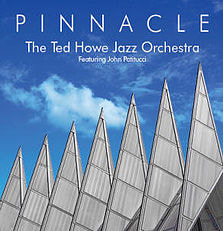 Pianist Ted Howe offered up one of the finest of Duke Ellington tributes, the piano trio set titled simply Ellington (Summit Records, 2005). It was a heartfelt ride through some of The Duke's most familiar tunes, swinging mightily. He now steps up into Ellington-ian ensemble territory with Pinnacle, by his thirteen piece Ted Howe Jazz Orchestra. In the old "is it classical, is it jazz?" discussion, Pinnacledefinitely leans classical—but it does swing. Opening with "Presto for Two Trombones," Howe's arrangement sounds less like Ellington and more like those of trombonist J.J.Johnson on his work with trumpeter Dizzy Gillespie on Perceptions (Verve, 1961), brassy and magisterial before it breaks into a deep groove. Trombonists Andy Martin and Francisco Torres rip it up on their solos, and bassist John Patitucci sears his solo while his rhythm mates, guitarist Dan Baraszu and keyboardist Geoff Haydon, give the piece a ringing modernity, with a Latin tinge injected by percussionist Jose "Bam Bam" Ramirez. "Impromptu for Trumpet" is another grand, sweeping statement, a showcase for horn man Lester Walker, who plays a beautiful lead around the harmonic gusts of the orchestra. Howe centerpieces the CD with "Suite #1 for Jazz Orchestra." The piece is comprised of three six minute movement: "Movement 1" an airy landscape that brightens out of a gray murk like a sunrise, with electric undercurrents from guitar and rhodes keyboard. "Movement 2" contains some of set's most gorgeous harmonies, one of Ellington's greatest strengths, and we could mention Maria Schneider in this context, too, for comparison—working, again, a light/dark dynamic. Ellington is evoked on "Movement 3," with trumpeter Lester Walker coming to the front again, growling around a Cotton Club plunger mute. Swing is king here, with drummer Marlon Patton's muscularity driving the music forward. A beautiful, masterfully constructed and arranged suite. The eleven minute "Adagio for Piano" gives pianist Ted Howe a chance to step out on his instrument, with a spare, melancholy solo intro, two minutes of ruminative beauty, joined then by a gentle burst of bass and drums, followed by the orchestra's sound seeping up out of the flooring to create a resplendent, sweeping panorama, an ebb and flow of brass and reeds shot through with Howe's inspired pianism. The closer, "Jazz Etude for Three Clarinets" brings back an Ellington mood, with jungle drums pounding behind the wailing, snaky reeds, an exciting and upbeat wrap-up for an extraordinary orchestra jazz set.
- Dan McClenaghan c/o All About Jazz |
Categories
All
Archives
May 2021
|
|
Media
|
Services
|
Live
|
Store
|
© 2000 - 2023 Ted Howe | All rights reserved

 RSS Feed
RSS Feed